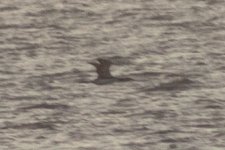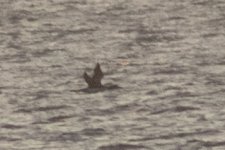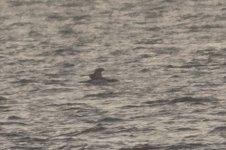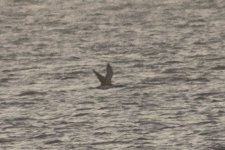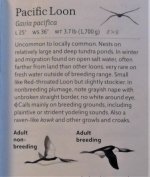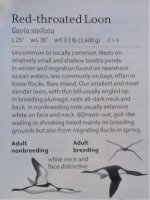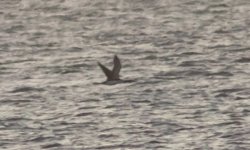Any photos are worth a try, in my opinion. I don't have any personal experience with Pacific Loon. I'd say your bird definitely does not look like a Common, but I can't say either way on Red-throated vs. Pacific.
My favorite guide for waterbirds in flight (by far) is the Peterson Seawatching Guide (Behrens and Cox 2013), so I took a look at their accounts for both species. I'm not sure exactly what you mean by "rear loaded" for Red-throated, but the guide describes Red-throated in flight as (paraphrasing here) tilted forward, with wings set farther back on the body. Pacific is supposed to be more evenly proportioned, as you mentioned, but I'm not sure which way to decide on these photos.
Another mark the authors list for Pacific is a shorter neck. This is the one feature that I doubt most in your photos, since your bird looks pretty long-necked to me. It could be a minor point, though.
It's tough to say much on plumage, especially given the backlit/poorly lit conditions.
I have to say, I don't know how people pick out Pacific Loon as a distant flyby on the East Coast, either, but somehow they key in on those finer details.
that is what I meant by rear loaded, the wings are set further back. I have that guide, and I will have to take another look at it. Thank you.
So far I have gathered some very knowledgeable opinions here as well as offline, all of which are unsurprisingly hesitant to put out any claims to species. I know the commenters here to all be regular contributors on the forum whose opinions I value greatly, so thank you all. Several of the commenters have either stated that they can not rule out Common from these photos, or they question how I ruled out Common, which makes me pause to wonder about that. I’d be interested to hear more about why you say it definitely does not look like a Common to you.
Keep in mind that the commenters are only going by these bad photos. I never considered Common in the field because it just didn’t look like one to me. I’ve been seeing tons of migrant Red throated lately, and very few Commons in flight as active migrants, like 1 for every 200-300 red throated, which is pretty typical for this time of year here. There are plenty of Commons around, but they’re all mostly loafing around, I usually see about 10, give or take at each site, each day sitting around in the surf, while migrating Red throated have been ranging from 50-500 a day over the past week, with 1-3 hour observation periods. I have a very good feel for the size of Red throated right now, they’re pretty engrained in my mind. This one came during the middle of an observation period, preceded by at least 100 Red throated and 0 Common in flight by that point in the watch. This bird really stood out immediately by its size. It definitely had bigger feet and maybe a slightly thicker neck, but the neck was very subtle, it was mostly the feet. While the feet did seem big, if I am not mistaken, usually Common Loon feet look bulbous. These looked safely intermediate, but large enough to be sure they were larger than the other birds seen to that point. I had a hard time in the field being completely sure it wasn’t a Red throated, whereas Common Loon feet usually are a fairly easy clincher in my experience. Among the tons of Red throated passing by, I frequently notice variations in their appearances, including the way they hold their necks, variations in plumage that can be accounted for mostly by various ages, and of course variations that I attribute to viewing conditions that make me settle for being 95% sure that Red throated is a safe ID. This bird had me feeling VERY unsure this was Red throated, but I have never had much of an issue with identifying Common Loons before. This absolutely could be a case of Common Loon, I have to wonder, especially now in photo review with that question being challenged by more than 1 respected contributor. I remain marginally confident of my original impression on that front, because in addition to the size, the color of the neck seems wrong. It never appeared to have much white on the chin, and as a matter of fact it, appeared to have even less white around the chin than I usually see on immature Red throated, which is substantiated by the photos I think.




